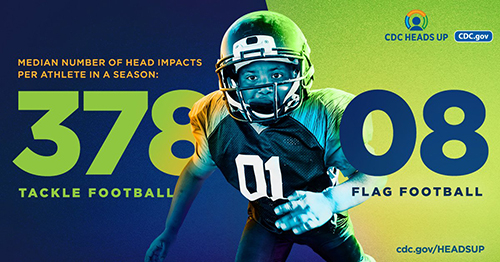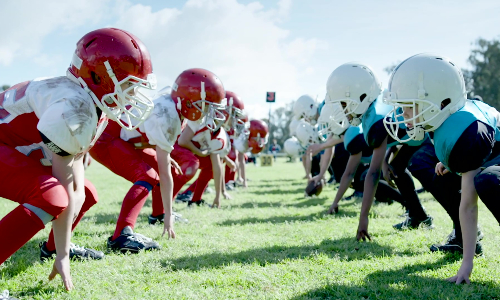A youth football video made you sick. But is some outrage misplaced?
By Chris Nowinski, Ph.D.
Concussion Legacy Foundation co-founder & CEO
You know the video, even if you haven’t seen this version yet. A semi-circle of young boys with enormous-looking football helmets watch two of their teammates line up across from one another. A whistle blows, and the two players – who perhaps weigh 100 pounds combined, if you count the helmets – sprint straight at each other and collide.
We hear the CRACK of the helmets and watch the horrifying whiplash of the younger, lighter, or less prepared boy as he falls in a heap to the ground.
Choose Flag Football Under 14. pic.twitter.com/KWMK3kkjkL
— Chris Nowinski, Ph.D. (@ChrisNowinski1) May 11, 2021
Cue the Twitter outrage from fans, coaches, TV personalities, and even the CEO of USA Football.
“This drill needs to be banned!”
“The weaker player is clearly outmatched – that’s on the coach.”
“This is against everything we stand for.”
If you are part of the social media pile-on decrying bull-in-the-ring drills and ill-informed coaches, I’d like you to consider that your anger may be misplaced.
Is there really a safe way for a 40-pound child wearing a gigantic 4-pound helmet to run at another child and tackle him to the ground? I’d argue there is not. While the coaching is horrendous, it isn’t the biggest problem with this viral video, and it won’t be the problem when we get angry about a similar video next year. The existence of youth tackle football is the bigger problem. Because even “well-coached” tackle football with “evenly matched” players is inappropriate and dangerous for young children while their brains are developing.
When you start children in tackle football while their age is still a single digit, you are essentially priming them to develop the neurodegenerative disease Chronic Traumatic Encephalopathy (CTE). The perception that CTE is a problem exclusively for NFL players is a myth. The research tells us you don’t need to play at the highest levels of football to develop CTE; you just need to play long enough.

A 2019 study by researchers at Boston University and the US Department of Veterans Affairs published in the Annals of Neurology concluded the risk and severity of developing CTE is not correlated to the number of concussions one receives, but is instead correlated with the number of years spent playing tackle football. Their odds of developing CTE appear to go up 20 to 30% per season they play. That means that a high school football player who starts tackle football at age 5, instead of age 14, may have an incredible 10 times the risk of developing CTE.
Symptoms of CTE include explosiveness, impulsivity, rage, violent outbursts, having a “short fuse” or emotional lability, depression, paranoia, cognitive impairment, memory loss, and dementia.
This alarming data means that if you start your child too young, and they succeed, their brain is in peril. Signing a child up to play a season of tackle football may not put them at a noticeable risk of CTE. But a coach’s job is to teach the child how to play well, and to enjoy the game. If that coach is successful, the player may go on to play in high school, and by then they will already have a significant risk of developing CTE. If they start at 5 and go on to play in college, the risk would be even higher. So if you have a promising football player in your care, the last thing you want them to do is play youth tackle football. The brain can only take so much trauma. If you wait until high school, they may learn the lessons of the game and avoid CTE.
If you are still an advocate for youth tackle football because you believe children can be taught to tackle safely, I’d argue you are using the wrong measure of safety. They may survive each individual tackle, but eventually all those tackles can catch up to them. Many of the hundreds of former football players with CTE in our brain bank were the best tacklers on their team or were known for good form. But even the most skilled tacklers are often surprised when a ball-carrier changes direction at the last moment.
The science says young children also do not have the brain development to consistently tackle safely, no matter how much you train them. If you really believe five, six or seven-year-old children can control their bodies well enough to tackle and be tackled with perfect form each time, are you open to letting them try other activities we restrict to adults? Go ahead and teach your five-year-old to drive. Then tell me you are surprised when they drive you into a tree. Sure, you can teach them the rules of the road, and perhaps even how to safely drive around an empty parking lot, but do you trust them to execute it all safely on the highway going 65 in the rain?
A better choice for youth players is flag football. A U.S. Centers for Disease Control (CDC) study published in February, 2021 in Sports Health reported youth tackle football athletes ages 6 to 14 sustained 15 times more head impacts than flag football athletes during a practice or game and sustained 23 times more high-magnitude (hard) head impacts. The study also measured the total number of head impacts experienced during the season. Researchers found youth tackle football athletes experienced a median of 378 head impacts per athlete during the season compared to only eight head impacts for flag football athletes.

Remove bull-in-the-ring from youth tackle football, and you’re left with a sport that may produce fewer viral videos, but one that is still exceptionally dangerous for young children to play. No child should receive 378 head impacts in a season.
My advice to parents is simple: if you wouldn’t hit your child in the head 50 times a week in the fall, don’t let other people do it to them either. The brain develops in profound ways during its journey to adulthood. Every season of hits can change the brain and therefore change the child.
Just ask the families of John Gaal Jr., Evan Hansen, or Kenny Keys whether CTE can affect football players who never made it to the pros. John, Evan and Kenny are three of the more than 1,000 former athletes and military Veterans whose brains have been donated to the VA-BU-CLF Brain Bank after death for research on CTE and other forms of brain trauma.
As a former All-Ivy football player-turned neuroscientist who has watched CTE destroy hundreds of families, I have dedicated my life to preventing CTE. We launched Flag Football Under 14 to encourage parents to delay enrolling their children in tackle football until age 14. We estimate that if all football players started playing tackle at age 14, we would eliminate more than 50% of future CTE cases.
You can learn more about CTE and the dangers of youth tackle football using the links below. What you won’t find is a page on how to coach youth tackle football responsibly. There is simply no safe way to do it. So next time a viral video pops up of a big youth football hit, I hope you’ll help us ask the question that really needs to be asked: why are we letting young children hit each other in the head hundreds of times each year?

